2009 Q&A ArchiveUkulele History & Vintage Ukuleles:
Questions, Answers, and Information
2009 Archive
Click Here to Ask a Question or Send Information
Date: March 23, 2009
Question:
I play a number of stringed instruments and thought it would be fun to also learn ukulele. I am having fun learning, but have no idea as to the identity of this ukulele I found in an antique store. The only identification is a small label inside reading "GENUINE HAWAIAN (sic) KOA WOOD." What is this ukulele?
Answer:
Your ukulele was made by the Oscar Schmidt Company of Jersey City, NJ. Schmidt used the misspelled "Genuine Hawaian Koa Wood" label on some of their early ukuleles. I would estimate that your ukulele was made in the later teens or early 1920s. Most Oscar Schmidt ukuleles are rather inexpensive models. Yours is definitely one of their higher-end models, with the fancy headstock shape and nice koa wood. It also appears to be in great shape considering the age - congratulations on your nice find.
|  | 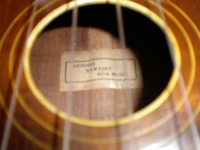
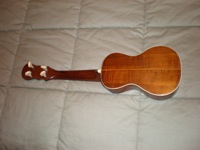
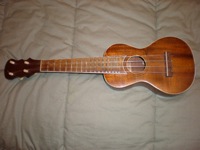
|

Date: March 24, 2009
Question:
We're trying to find some information about this ukulele. The label inside has a sailing ship and AW Ukuleles, Stowe, Vermont. There's also pencil writing inside that seems to say "Baker". Any info would be appreciated. Thanks.
Answer:
Your ukulele was made by the Green Mountain Violin Corporation of Stowe, Vermont. They were a small company that originally made violins, but early in 1922 they branched out into the field of ukuleles and banjo-ukuleles. Their violins were sold under the "Artcraft" brand, while their ukuleles, banjo-ukuleles, and banjo-mandolins were marked "A.W." The "A.W." stood for "All Warranted". The company made instruments out of native Vermont woods. Unfortunately, it doesn't appear that they were around for too long. In June of 1922 a fire destroyed the factory and work stopped completely. Plans were made for re-organization, but I haven't found any evidence that the company ever produced instruments again.I have seen a few Stowe ukuleles before, and they seem to be patterned after the ukuleles that C.F. Martin & Co. was making at the time. They appear to be a good quality instrument, but I have never played one so I can't say much about the sound. I have never seen one with a label before, so thanks for sending the photos of yours. I assume that it was made in 1922, quite possibly the only year the A.W. ukuleles were made. As for the name Baker written in the uke, I'd guess that may have been the name of the original owner. Your ukulele is an unusual brand that doesn't turn up all that often. It appears to be in very nice condition.
|  | 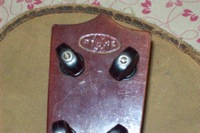
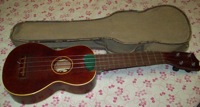
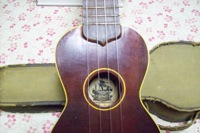
|

Date: March 23, 2009
Question:
Can you tell me anything about this Rolando?
Answer:
You have a very early banjo ukulele. Rolando was a brand name used by the Southern California Music Company on banjo ukuleles and guitars (and possibly other instruments). Southern Cal even sold some Martin guitars with Rolando labels inside. Your banjo ukulele was probably made between 1916 and 1920. It was almost certainly made in California - nearly all the very early banjo ukuleles were. It was quite possibly made in the factory in the Los Angeles area that was the largest banjo ukulele manufacturer at the time. Your instrument is made from burled redwood, other (more common) styles of Rolando banjo ukuleles were made from alternating light and dark wood pieces. The hole in the headstock is original - every one of these I have seen has the same hole there.
|  | 
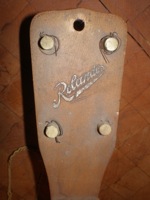
|

Date: March 23, 2009
Question:
I have recently acquired this Martin Ukulele. From the little research I have done it looks to be a Tenor model made around 1930 or earlier. It looks to be in good shape with no visible cracks and a few minor scratches. I was going to get some Martin Nylon strings and start playing it.Am I on the right track about the vintage and model? Any other thoughts?
Answer:
As you surmised, your ukulele is an early Martin tenor made between 1928 and 1934 or thereabouts. It is a style 1T. It does look to be in very nice shape and it is great to find one with its original hardshell case. I agree you should get some nylon strings and get playing on it - it looks like a very nice instrument.
|  | 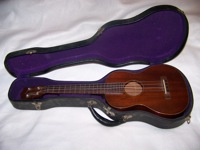
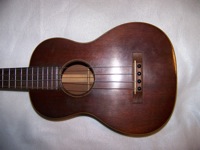
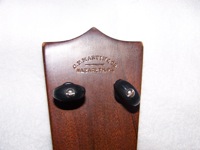
|

Date: March 23, 2009
Question:
Hello, I have this vintage soprano and I can't find any number, any brand or any sign to identify it. It plays well in BF#DA without buzz and with a low action. Could you help me to put a name on and an era of fabrication. Many thanks and good day.
Answer:
Your ukulele was made by the Harmony Company of Chicago, Illinois. The bridge shape, soundhole decal, and pearloid fretboard are all clues that your ukulele is a product of the Harmony Company. I believe that your ukulele dates to the 1930s. Harmony was owned by Sears at the time, but produced instruments for that were sold by many different retailers and jobbers. The fretboard and headstock on your ukulele are made from Pyralin - a plastic that resembles mother-of-pearl. These days, most vintage instrument dealers and collectors refer to it as "mother-of-toilet-seat" (MOTS).
|  | 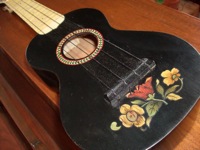
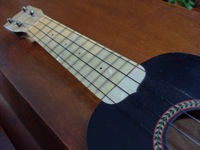
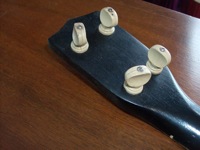
|

Date: March 23, 2009
Question:
I was wondering if you might be able to tell me some info about this instrument.I have never seen another with the five string and headstock on it as this one does. It is really a beautiful instrument in looks and sound and a joy to play. Thanks
Answer:
Your ukulele is a product of the Aloha Ukulele Manufacturing Company. The company was in business from 1917 to 1935 in Honolulu. The main ukulele builder there was Tai Chong Goo, who worked under the pseudonym Akai. The unusual headstock shape on your ukulele was used on many Aloha and Akai ukuleles, and I have never seen it used by another maker. While standard Aloha ukuleles are not particularly rare, yours is an extremely unusual model. I have never before seen a five-string model from the company. It is what is known as a five string taropatch, an instrument related to the Portuguese rajao. These were more popular in Hawaii in the late 1800s and very early 1900s. By the time yours was manufactured the eight-string taropatch had become common, and very few five-stringers were made. The eight string taropatch took on the tuning of the four string ukulele. The five string taropatch was typically tuned DGCEA, and that tuning is likely the source of the modern ukulele tuning. Taropatches were typically bigger than standard soprano ukuleles. Most sopranos are between 20 and 21 inches long overall, while a typical five string taropatch is about 26 inches overall.
|  | 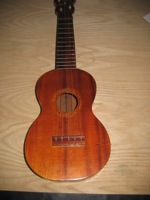
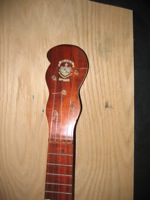
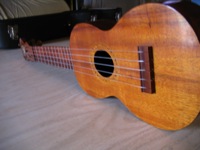
|

Date: March 23, 2009
Question:
Hello Can you please give me some information about this old kamaka? Thanks!
Answer:
Your old Kamaka ukulele is great. It looks to be very early to me - probably made between the late teens and the mid 1920s. It is a very fancy model with the inlay on the sides and center of the neck. The decal is a rare Kamaka decal - I have only seen a couple of ukuleles with that particular decal. All in all it looks to be a very unusual and desirable old Kamaka - thanks for sharing the photos.
|  | 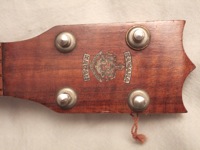
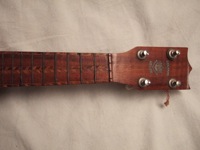
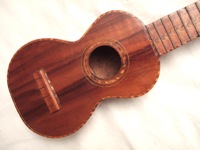
|

Date: March 22, 2009
Question:
This ukulele has been up on a shelf in my grandma's house for as long as I can remember. She told me that it almost got thrown out by her sister when her mother died, but she decided to hold on to it for decoration. She said that it never really got played. She recently gave this uke to me. I have done some research and although I was not able to find much, I think this may be a Lyon and Healy. I have seen photos of similar Camp Ukes, but none with the gold leaves on it. The bridge doesn't appear to be original, there are a few small cracks in the sound board, and there is a water mark on the side, but other than that it is in good condition. The two things that I find the most unique about it are the round body and the rounded back. I would like to find out more about this uke if it is possible. Thanks!
Answer:
Your ukulele is definitely a Lyon and Healy Camp Uke. The gold leaf design makes this the high-end of the Camp Uke line. Lyon and Healy was one of the big distributors of musical instruments based in Chicago. The "Camp Uke" name was used on a line of ukuleles that included models that ranged from low to mid-priced. They are pretty durable little instruments and can sound pretty good. There were a number of different models made through the 1920s, all with round bodies. Some models had no soundhole at all, while more often they featured a circular or oval soundhole (like yours). Some have a flat wooden back, others have a turned wooden back. Fancier models like yours featured a gold-leaf decal below the bridge.The "Camp Uke" name was registered by Lyon and Healy in 1923, but they claimed first use in 1921. Lyon and Healy used unusual woods on some of their ukuleles. The Camp Ukes were made from Nyssa wood. The 1925 Lyon and Healy catalog features three models of Camp Uke all "made of two-ply, laminated Nyssa wood". It goes on to explain that "Laminated means that the wood is two layers, the grains cross-wise, carefully glued together. The one layer reinforces the other. Nyssa wood is strong, not easily cracked, and possesses wonderful vibrating qualities." The catalog states that the Camp Ukes are "exclusive Lyon and Healy products, made in the famous Washburn factory". The three models sold for $6.00, $7.50 and $10.00. Yours is the $10.00 model. In the early 1920s, your Camp Uke sold for the same price as a Martin Style 0, $10.
|  | 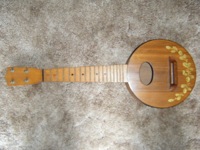
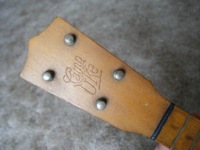
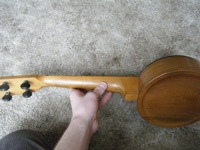
|

Date: March 22, 2009
Question:
Dear Ukulele Hall of Fame, My wife has asked me to get some information about this Kaai ukulele. It looks old to me- the label inside has faint pencil writing: appears to have number 1727C, 727C, 172 C (hard to read). The case seems to be made for it and fits perfectly. Even though somewhat roughly crafted, the tone is amazing. I do not know how to tune one of these (I own and play a Fender Telecaster and Fender Super Reverb amp myself), and the strings don't look right to me. Please tell me what you can, much thanks.
Answer:
That is a very interesting ukulele you have. It looks to be made of koa wood and some very nice koa it is. Ernest Kaai sold ukuleles made in Hawaii as well as some that were mainland-made. It is hard for me to say for sure which of those you have. The heel of the neck isn't done in the typical Hawaiian ukulele fashion and the bridge is not typical of those found on Hawaiian-made ukuleles. Still, it is difficult to say who actually made it. According to John King's book "Hawaiian Ukulele and Guitar Makers 1884 - 1930" Kaai only used the 69 Young building address for one year - 1912. If your ukulele was actually made in 1912, then it was most likely made in Hawaii - I don't think there were any ukulele makers established on the mainland at that time. It was a high-end model when it was sold - lots of inlay and the fancy headstock shape. It is a very nice looking instrument. The standard tuning is GCEA with the C being the lowest note - so the strings don't go from thickest to thinnest in order.
|  | 

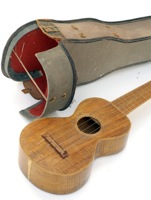
|

Date: March 22, 2009
Question:
Hello,I was wondering if you could tell me the approximate age of this Ukulele. Thank you very much.
Answer:
That is a Martin Style 2 soprano ukulele. It is made of mahogany. Assuming the tuning pegs are original, it was most likely made between 1950 and 1962. If it is marked "Made in USA" inside the soundhole under the Martin stamp then it is from 1962 or later. The Style 2 was the middle instrument in the Martin soprano ukulele line.
|  | 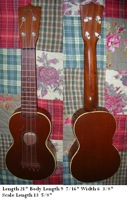
|

Date: March 22, 2009
Question:
I bought this uke at a local auction. It is not marked by a maker. It does have an added wood plack on the headstock that says, "Manufactured expressly for S. Ernest Philpitt Washington, DC , Miami, Tampa, Jacksonville Fla". The rope binding and skunk stripe are of very well done inlay. I think it is Hawaiian made with koa wood but I would like to know what your think. Any information you might have would be very nice.Thank you for your help.
Answer:
Your ukulele was made by the Oscar Schmidt Company of Jersey City, NJ. It is made from Hawaiian koa wood. Many mainland manufacturers made ukuleles in the Hawaiian style, primarily in the teens and 1920s. Some of the characteristics that mark it as an Oscar Schmidt include the style of binding inlay, particularly the stripe up the center of the back, as well as the headstock shape. These ukuleles often had a paper label inside with a seated hula girl and the words "Hawaiian Ukulele" in big letters at the top and "Manufactured by the Oscar Schmidt Co., Jersey City, NJ" in small letters at the bottom.
|  |
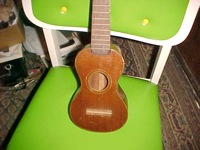
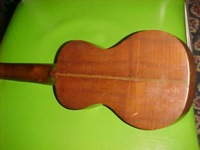
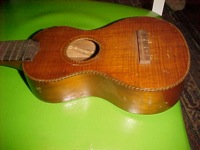
|
 |










